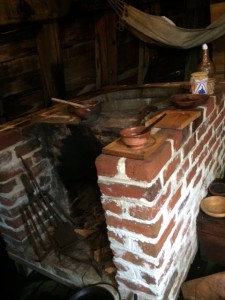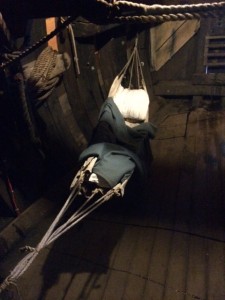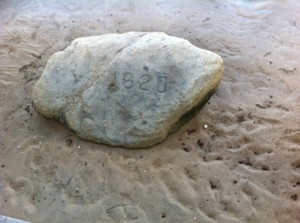The first stop for the third grade field trip to Plimoth Plantation on a wet and dreary day was the Mayflower II. It’s a replica of the Mayflower ship that the Pilgrims sailed on. We also learned about the life for Pilgrims and Native Americans.
Here’s a model boat version of the Mayflower at Plimoth Plantation.
On November 9, 1620, Mayflower’s crew first sighted land off Cape Cod near the Wampanoag village of Pamet. The next day, the ship attempted to travel south around Cape Cod to the colonists’ intended destination at the mouth of the Hudson River (present-day New York). Bad weather and dangerous shoals forced Mayflower’s master to turn back. The ship made landfall on November 11 at the tip of Cape Cod (present-day Provincetown). After exploring the Cape Cod area for several weeks, the colonists finally decided to settle at present-day Plymouth. from Plimoth Plantation

The complex sails and rigging for the Mayflower.

Actors portray the sailors on the Mayflower II
On Board the Mayflower II
We were able to go aboard the Mayflower II and explore the different decks and rooms. The passengers would have lived on board anywhere from seven to nine months.
This is a hammock where the sailors would have slept in.
There were other sleeping quarters as well: beds on the lower deck, bunks and rooms for the ship’s officers.

These sleeping quarters were for passengers.
My son’s homework from the field trip was to visualize life aboard the Mayflower II. You can really get a sense of what life was like from visiting Plimoth Plantation in a way that books or videos just can’t convey!
What my son learned from Plimoth Plantation and Mayflower II field trip.
The ship’s galley was essentially a fireplace that produced food for all 132 people! Hard to imagine!

The officer’s quarters were more spacious.
The ship was equipped with cannon.

Did they or didn’t they? This is the famous Plymouth rock, but only oral legend has recorded whether or not the Pilgrims actually stepped off onto this rock. Still, it’s preserved near the Mayflower II and it’s surprisingly small.
Mayflower Books for Kids
…If you Sailed on the Mayflower in 1620 by Ann McGovern
What kind of ship was the Mayflower? How did the Pilgrims feel when they saw land? What was the first building in Plymouth? In lively question-and-answer style, this fact-filled book answers all sorts of questions about the Pilgrims’ journey on the Mayflower and their first year in America.
Boys and girls will find out why the Pilgrims left England to live in America, what they took with them on board the Mayflower, and the hardships they endured. They’ll learn what the Mayflower Compact was, how the Pilgrims made a peace treaty with the Indians, and how these brave settlers managed to survive in their new land.
Ms McGovern has carefully researched the Pilgrims’ journey and their first year in America. Her portrayal is full of fascinating detail about their everyday life. Young readers will be intrigued to discover that Pilgrim boys and girls slept on corn husk mattresses they made themselves, and that most of the houses had only one chair — which was reserved for the man of the house! [advanced picture book, ages 7-10]
Mayflower 1620: A New Look at a Pilgrim Voyage by Plimoth Plantation
Plimoth Plantation and the National Geographic Society come together to tell the true story behind the legendary voyage of the Mayflower. A meticulously researched work, Mayflower 1620 offers children a compelling, fresh account of this much-told story. [advanced picture book, ages 8-12]
To examine any book more closely at Amazon, please click on image of book.
As an Amazon Associate, I earn from qualifying purchases.
p.s. Related posts:
Plimoth Plantation: Learning About Native Americans
Plimoth Plantation: Learning About Pilgrims
4th of July in Plymouth, Massachusetts
Contemporary Native Americans in KidLit
Notable Children’s Book Author Joseph Bruchac
Native American Picture Book of the Day
Top 10 Native American Books for Kids
Top 10 Best Native American Picture Books
Top 10 Best Native American Middle School Books
Top 10 Best Native American YA Books
Follow PragmaticMom’s board A Teachable Moment on Pinterest.
BEST #OWNVOICES CHILDREN’S BOOKS: My Favorite Diversity Books for Kids Ages 1-12 is a book that I created to highlight books written by authors who share the same marginalized identity as the characters in their books.


















My husband’s favorite place to visit. Definitely a favorite of Little Miss History, but then she has so many!
Hi Barbara,
I love your Little Miss History series! Maybe she will come to Plimoth Plantation soon?!
Great choices! Thanks for sharing. I’m particularly interested in Mayflower 1620 but it was checked out of the library.
Hi Alex,
I bet it will be back on the library shelves now that Thanksgiving has passed! Thanks so much for your kind words!
Grday to share this. Another friend visited Plimoth were her kids and I saw some videos. Great place for kids. It’s so important for kids to view history firsthand.
Almost two weeks ago, Dr. Henry Lewis Gates, on PBS’ “Finding Your Roots,” followed Sally Fields ancestry and discovered her family were Pilgrims, sailed on the Mayflower and her 6-7x great grandfather was the first mayor of Plimoth for 36 yrs. In a diary he kept he talks about a gathering with Native American that was sparse but satisfying — the origins of our Thanksgiving. It ran on PBS Nov. 17. Needless to say she was stunned.
Hi Patricia,
That’s so cool about Dr. Henry Lewis Gates tracing Sally Fields’ ancestry: http://www.pbs.org/wnet/finding-your-roots/sally-fields-loyalist-link/12519/
Thanks so much for sharing that!
We were able to make it out to Plimoth Plantation before leaving Massachusetts, I am happy to say! So much history there!
Hi MaryAnne,
It’s so great because kids can run and run and still experience history first hand! There’s absolutely nothing boring about it so I think it makes history interesting even for kids who don’t think they like it.